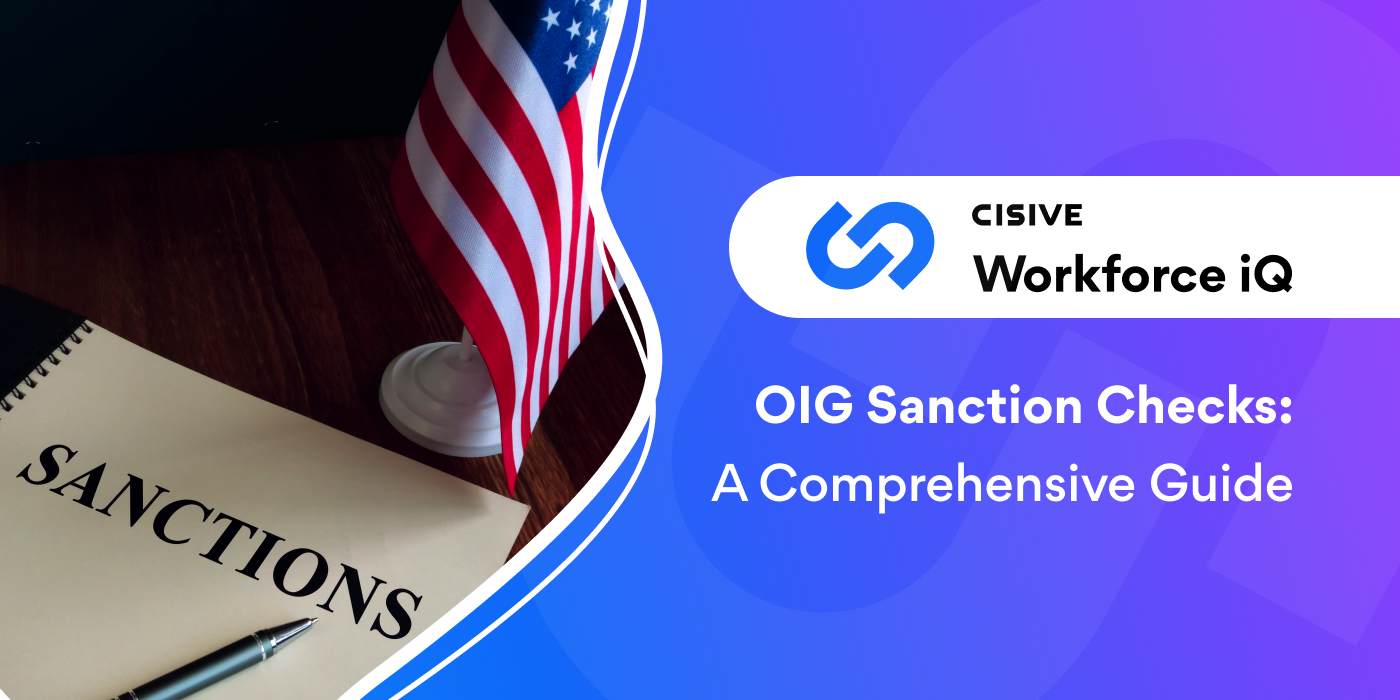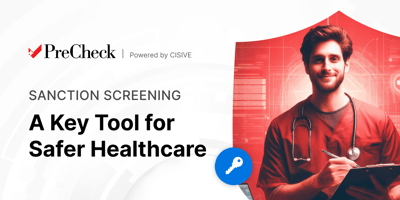

As PreCheck’s Principal Consultant for Sanction Screening, I work with healthcare compliance...

In the complex world of healthcare, OIG sanction checks are non-negotiable. These checks are far more than a simple formality during the hiring process: they are a critical component of protecting patients, ensuring compliance with federal regulations, and safeguarding an organization’s financial well-being and reputation.
No healthcare organization can afford to treat sanction checks as a one-time event. Employing someone who has been sanctioned by the Office of the Inspector General (OIG) risks being excluded from participating in Medicare and Medicaid as well as being on the hook for costly civil monetary penalties, says Heather Badjar, product manager at Cisive. This financial exposure could cripple an organization.
Nothing in healthcare is static, including employees’ good standing. Individuals and entities may face disciplinary actions or sanctions even after they clear an initial screening. This could be due to new criminal convictions, license revocations, or even defaulting on student loan repayments. Find out why relying on a single check creates a dangerous blind spot leaving your organization vulnerable.
To appreciate the importance of ongoing sanction checks, it's crucial to understand what healthcare sanctions are and why they matter. In simple terms, a healthcare sanction is an action taken by a regulatory body — most notably, the Department of Health and Human Services — to restrict individuals and entities from participating in federally funded healthcare programs like Medicare and Medicaid.
The Office of the Inspector General (OIG) maintains the List of Excluded Individuals and Entities (LEIE), a powerful resource used to monitor these sanctions. The LEIE is a comprehensive database of individuals and entities barred from participating in federal healthcare programs.
Healthcare organizations must regularly consult the LEIE and other relevant databases to ensure they are not employing or contracting with excluded individuals or entities.

Beyond the initial healthcare sanctions search, ongoing monitoring is crucial for several reasons.
First and foremost, conducting regular sanction check OIG screenings is a legal requirement for healthcare organizations participating in federal healthcare programs. Failure to comply can lead to serious consequences. The potential repercussions underscore the necessity of going beyond a one-time check. Ongoing monitoring helps you demonstrate a commitment to compliance and reduce the risk of inadvertently employing an excluded individual or entity.
Employing or contracting with someone on the LEIE can lead to significant financial penalties. “If they're employing somebody who's excluded, they can't receive funding for Medicare and Medicaid,, and they can also be fined hundreds of thousands of dollars for employing somebody who's excluded,” Heather says, highlighting the importance of proactive measures to prevent such situations.
Perhaps the most important reason for ongoing sanction checks is patient safety. Individuals on the exclusion list may have a history of behavior that poses a threat to patients. This could include patient abuse, fraud, or other serious offenses. By implementing ongoing healthcare sanctions checks, you can significantly reduce the risk of an excluded individual harming patients under their care.
While pre-employment screening is a crucial first step, it only provides a snapshot in time. To ensure ongoing compliance and protect patients, healthcare organizations must adopt a more proactive approach: ongoing sanction monitoring.
Life is full of unexpected turns. Circumstances can change rapidly, and an individual deemed suitable for employment today may engage in behavior tomorrow that leads to exclusion from healthcare programs. Healthcare sanctions screenings at the point of hire cannot predict future conduct. Ongoing monitoring helps you stay informed about any issues as they arise, allowing for timely and appropriate action.
Regular sanction checks should not be limited to new hires. Ongoing monitoring should include all employees, contractors, and vendors who interact with patients or handle sensitive information. “A lot of our clients send over their vendors for us to check,” Heather says, “so that they can ensure that an outside vendor isn't excluded as well.”
Implementing an effective ongoing monitoring program may seem daunting, but there are practical resources to help you streamline the process and ensure its effectiveness.
Third-party screening services offer a valuable resource for organizations seeking to implement ongoing monitoring. These services automate the process of checking individuals and entities against updated databases regularly, flagging any changes in sanction status, and alerting the organization promptly.
Integrating sanction check data into existing HR or workforce management systems streamlines the process. This integration facilitates centralized tracking, reporting, and access to up-to-date information, making it easier to manage the monitoring process effectively.
A healthcare sanctions check goes beyond confirming basic information. They uncover potential risks by examining an individual’s past, focusing on key areas that could indicate a threat to patient safety or compliance with healthcare regulations.
These checks reveal information related to potential misconduct, fraud, or abuse within the healthcare industry. This information is vital for healthcare organizations to make informed decisions about hiring, contracting, or continuing relationships with individuals and entities.
Here are some key areas that healthcare sanctions checks focus on:

To implement a robust and effective ongoing sanction check program, consider the following best practices:
A clear written policy is essential for any successful compliance program. This policy should outline the procedures for healthcare sanctions screenings, the frequency of these screenings, and the scope of individuals and entities covered. It should also address how to manage positive matches and maintain detailed records of all screening activities.
Relying on the OIG’s List of Excluded Individuals and Entities (LEIE) alone is insufficient for a comprehensive healthcare sanctions screening. To ensure compliance, you should also consult additional databases such as the GSA System for Award Management, state Medicaid exclusion lists, and other federal and state exclusion sources.
This multi-source approach ensures that no sanctioned individual or entity is overlooked, minimizing compliance risks and protecting your organization's eligibility for Medicare and Medicaid reimbursements.
Regular training is essential to keep staff informed and equipped to handle the complexities of sanctions checks. Training programs should include updates on policies, regulatory changes, and best practices for managing sensitive data and ensuring accuracy. Well-trained employees can confidently interpret results and address potential compliance risks, strengthening your organization's ability to stay ahead of evolving regulations.
Partnering with a reputable screening provider simplifies the complex process of healthcare sanctions checks. Expert providers offer access to comprehensive databases, deliver clear results, and streamline processes to reduce the burden on internal teams. By working with a trusted partner, you can ensure your organization remains compliant and protected from financial and operational risks tied to exclusions.
Ongoing OIG sanction checks are not merely a checkbox on a compliance to-do list. They are a critical investment in patient safety, regulatory compliance, and the long-term success of any healthcare organization.
By moving beyond a static, point-in-time approach and embracing ongoing monitoring, you can proactively identify potential risks, mitigate financial and reputational damage, and, most importantly, protect the vulnerable patients they serve.
Want to learn more? Discover exclusion and sanction monitoring that provides peace of mind.
Author: Jenni Gallaway
Bio: Content Marketing Manager at Cisive. 8 years of experience in the background screening industry.
Let's Connect on LinkedIn
As PreCheck’s Principal Consultant for Sanction Screening, I work with healthcare compliance...

Healthcare sanctions background checks play a vital role in safeguarding patients, protecting...

Healthcare organizations are responsible for ensuring they hire trustworthy employees and engage in...